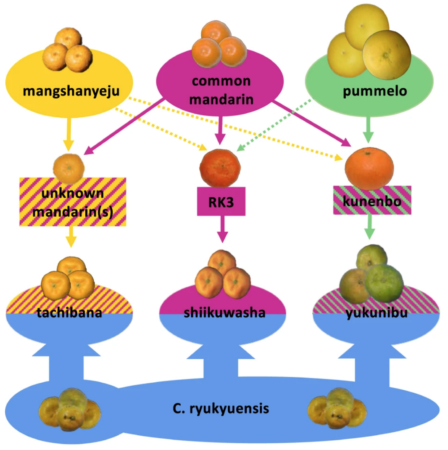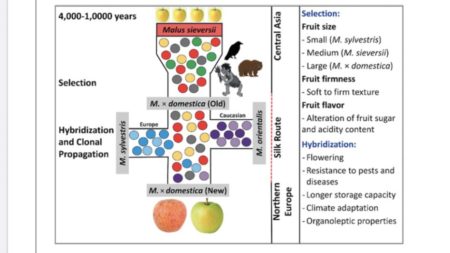- Duration of agriculture and distance from the steppe predict the evolution of large-scale human societies in Afro-Eurasia. Large, complex human societies arise where there is a long history of agriculture and war; and not, interestingly, where potential productivity is highest.
- Diet, Mobility, Technology, and Lithics: Neolithization on the Andean Altiplano, 7.0–3.5 ka. It seems the rise of large, complex societies arose in the Andes is associated with the change in projectile technology from atlatl to archery.
- Three-dimensional X-ray-computed tomography of 3300- to 6000-year-old Citrullus seeds from Libya and Egypt compared to extant seeds throws doubts on species assignments. Meanwhile, across the Atlantic, people were snacking on watermelon seeds.
- From the earliest farmers to the first urban centres: a socio-economic analysis of underground storage practices in north-eastern Iberia. You can track socioeconomic changes in ancient Iberian cultures (c. 5600–50 BC) via the size and morphology of their grain silos. No word on projectile technologies nor watermelons though.
- Re-evaluating Scythian lifeways: Isotopic analysis of diet and mobility in Iron Age Ukraine. Meanwhile, back on those steppes, 700-200 BC, some people were relatively settled, with their agro-pastoralism and millet agriculture, while others moved. So much for warlike nomads. Must have had watermelons by then, surely.
- Why were New World rabbits not domesticated? Because they’re solitary, dispersed and there’s too many different types. Most North American evidence of management comes from Teotihuacan, ~AD 1–550.
- Estimating the age of domestic fowl (Gallus gallus domesticus L. 1758) cockerels through spur development. In Britain, Iron Age and Roman cockerels died way too old to have been kept for meat, and were thus probably also used for rituals and cockfighting. No word on the Killer Rabbit of Caerbannog.
- The earliest water buffalo in the Caucasus: shifting animals and people in the medieval Islamic world. The water buffalo came to Azerbaijan with Islam in the 7-9th centuries.
- Collagen fingerprinting traces the introduction of caprines to island Eastern Africa. Goats from the 7th century CE, sheep a couple hundred years later. No word on water buffaloes.
- An illustrated review on manifestation of pome fruit germplasm in the historic miniatures of ancient Persia. 14-18th century Persian artists had a thing for pears, quinces and apples, and drew them very accurately.
Boffins unravel mandarins
I was just going to include the paper Diversification of mandarin citrus by hybrid speciation and apomixis in a forthcoming Brainfood, but the very different approaches taken in the two articles on the paper that I have seen convinced me to give it a bit more space.
The piece in The Packer has very much the industry take, and highlights the contribution of the University of Florida authors: this new information will make breeding easier, including to fight citrus greening.

On the other hand, the press release from the Okinawa Institute of Science and Technology makes much more of how the paper unravels the origin of shiikuwasha and tachibana, which are culturally important citrus fruits in Japan, though not very significant economically.
Something for everyone.
Nibbles: Black sheep, Salty rice, Spanish melons, Olive diversity, Food sculpture, Seed art, Navajo peaches, Grain amaranth, PNG yams, Avocado recipes, Abbasid cooking
- Just back from a nice holiday, and greeted by Jeremy’s latest newsletter, which includes, among many delights, a post from Old European Culture on black sheep in the Balkans.
- Traditional salt-tolerant rice varieties making a comeback in India.
- Traditional melon varieties exhibited by genebank in Spain.
- Trying to make the most of traditional olive varieties.
- Traditional foods are depicted in stone on Seville’s cathedral.
- And more recent attempts to celebrate biodiversity in art.
- I guess one could call traditional these old peaches that used to be grown by the Navajo. Have blogged about them before, check it out.
- No doubt that amaranth is a traditional crop in Central America. I doubt that it will “feed the world,” but it can certainly feed a whole bunch more people. Thanks to people like Roxanne Swentzell.
- There’s nothing more traditional than yams in Papua New Guinea. For 50,000 years.
- How to remix a traditional food like stuffed avocado.
- How many of the traditional recipes in these Abbasid and later Arab cookbooks have been remixed, I wonder?
Nibbles: Hedges, Mais, Papas, Protein
- Well of course there’s a hedge collection.
- Downloadable UNAM volume of the origin and diversification of maize (in Spanish).
- Catalog of the native potatoes curated by Indigenous communities in a region of Peru.
- I’m all for protein diversification, but what exactly is it?
Apple domestication visualized
The chapter on the Origin of the Domesticated Apples in the recent book on The Apple Genome has a really useful diagram which I hope I won’t get into trouble for reproducing here.

That really is worth a thousand words and more. Wish we had similar ones for all crops.